Top notes create your fragrance's essential first impression within seconds of application, lasting 5-30 minutes before fading. These light, volatile molecules – typically citrus, herbs, or spices – determine whether people are drawn to or repelled by your scent. You'll need to carefully balance these fleeting notes, as they make up 20-30% of your overall fragrance composition. Understanding how to select and blend top notes can transform your perfume from ordinary to extraordinary.
The Science Behind Top Note Volatility
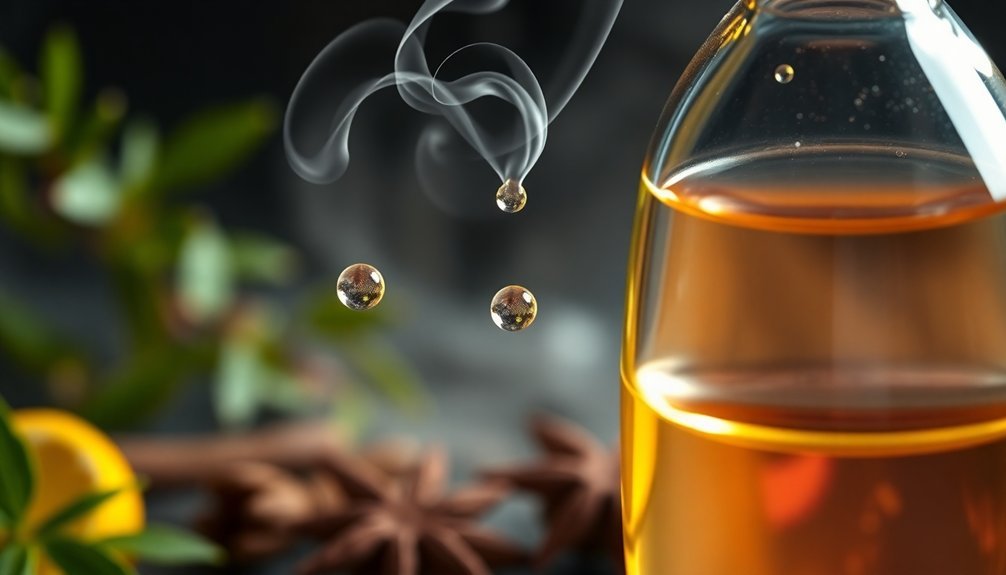
When you first spray a perfume, the top notes immediately spring into action, creating your initial impression of the fragrance.
These lightweight molecules are designed to evaporate quickly, typically lasting only 5 to 30 minutes before fading away. You'll notice bright, energetic scents like citrus fruits and fresh herbs that catch your attention from the start.
The science behind top notes revolves around their volatile nature. Their rapid evaporation isn't just a limitation – it's a carefully engineered feature that shapes your entire fragrance experience.
While their lasting impression may be brief, these opening notes play a significant role in determining whether you'll fall in love with a scent. Without appealing top notes, even the finest perfume risks being dismissed before its deeper layers can unfold.
Essential Oils Perfect for Top Notes
Three categories of essential oils dominate the world of top notes: zesty citrus, fresh herbs, and aromatic spices.
If you're looking to craft a fragrance with an unforgettable first impression, you'll want to explore these options.
Citrus essential oils like lemon, bergamot, and orange deliver that bright, revitalizing burst you'll notice immediately.
For a lively, invigorating opening, try incorporating herbal oils such as mint and lavender.
Want something more distinctive? Consider ginger or eucalyptus to add complexity to your fragrance's initial profile.
These top notes will evaporate within 15-30 minutes due to their light molecular structure, but they're vital in setting the stage for your fragrance's complete journey.
Your choice of essential oils here will shape how the entire scent unfolds.
Balancing Citrus With Herbal Elements
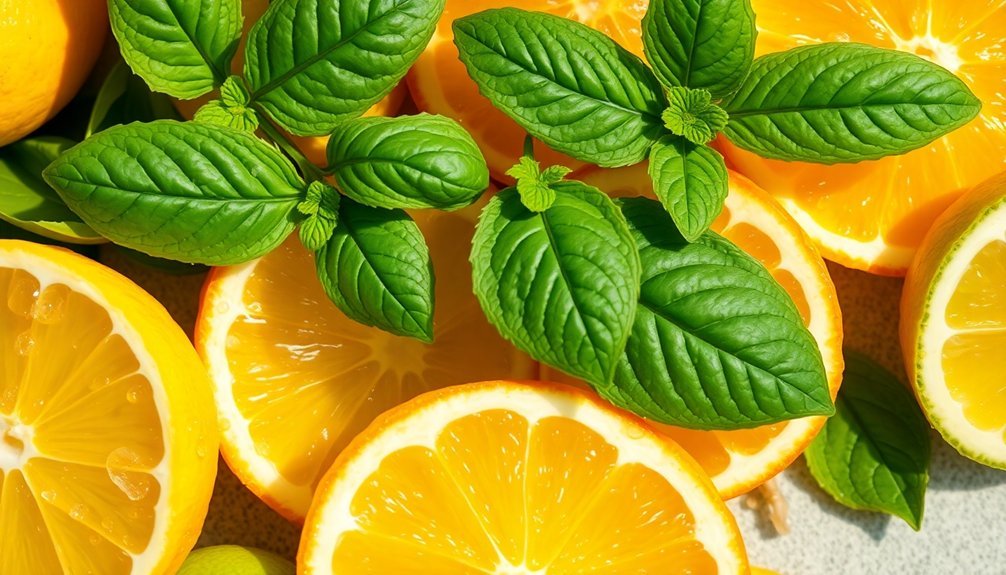
When you're working with top notes, combining fresh citrus with earthy herbal elements creates a dynamic opening that captivates the senses.
You'll find that zesty notes like lemon and bergamot naturally complement herbs such as mint and lavender, producing a balanced and sophisticated blend.
These carefully paired combinations prevent the fragrance from becoming too sweet while maintaining an invigorating character that shifts smoothly into the heart notes.
Fresh Meets Earthy Notes
The delicate art of balancing fresh citrus with earthy herbal notes creates some of perfumery's most enchanting top notes. When you experience this masterful combination, you'll notice how citrus elements like lemon and bergamot immediately capture your attention with their vibrant energy.
These bright notes don't stand alone, though – they're expertly grounded by herbal companions like mint and sage.
You'll find this perfect balance creates a dynamic journey that's neither too sharp nor overwhelming. Instead, you're treated to a sophisticated blend where freshness meets earthiness, setting the stage for the fragrance's evolution.
As you wear the scent, you'll appreciate how this careful layering adds depth and intrigue, making the top notes more engaging and complex than either element could achieve alone.
Zesty-Herb Combinations Work
Perfumers have long recognized the winning formula of pairing zesty citrus with herbal elements in top notes. When you experience this combination in your fragrance, you'll notice how the bright, energizing qualities of lemon or bergamot blend seamlessly with herbs like mint or lavender.
This pairing creates an immediate, revitalizing impact that sets the stage for the rest of your scent journey.
While citrus top notes quickly fade within 15-30 minutes, their herbal companions extend the opening experience, ensuring a smooth progression into the fragrance's heart notes.
You'll find these combinations particularly effective because they:
- Create an invigorating first impression that awakens your senses
- Balance brightness with depth for a complex opening
- Provide energy and clarity, making them perfect for daytime wear
Measuring and Mixing Top Note Ratios
Creating a perfect fragrance requires mastering the delicate balance of top note ratios, which typically make up 20-30% of the overall composition. These top notes are usually lighter molecules that evaporate within 5-15 minutes, setting your fragrance's first impression.
| Ratio Type | Effect |
|---|---|
| High Citrus | Bright, energetic opening |
| Low Citrus | Subtle, sophisticated start |
| High Herbal | Fresh, natural entrance |
| Low Herbal | Gentle, refined beginning |
You'll need to carefully measure and adjust these ratios to guarantee they complement your middle and base notes. Remember, while top notes create that initial impact, they must seamlessly shift into the heart of your fragrance. Experiment with different combinations until you find the perfect balance that captures your desired scent profile.
Common Top Note Blending Mistakes
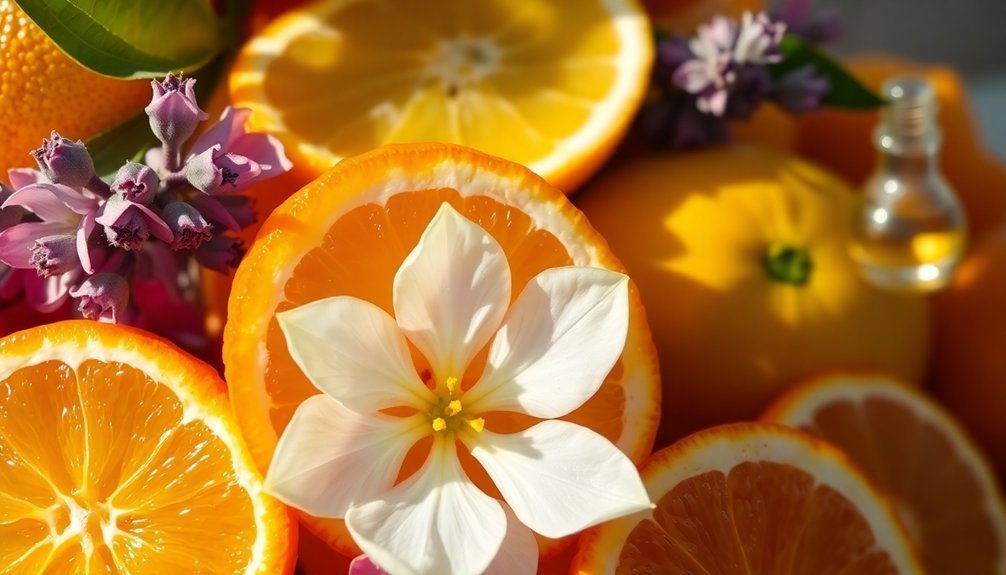
Mastering top note blends requires avoiding several critical pitfalls that can derail your fragrance creation. You'll want to be particularly careful not to overload your blend with citrus top notes, which can create an overwhelmingly sharp first impression.
Remember that top notes typically last only 5-30 minutes, so you need to guarantee they shift smoothly into your middle and base notes.
Key mistakes to watch out for include:
- Failing to balance volatile ingredients like ginger or mint
- Not considering how top notes interact with individual skin chemistry
- Overlooking the importance of proper shifts to base notes
When you're working with top notes, always test your blends thoroughly and pay attention to how they evolve over time. This will help you create fragrances that make lasting impressions rather than fleeting experiences.
Creating Signature Top Note Combinations
When you're ready to develop your own distinctive fragrance, signature top note combinations can set your creation apart from conventional scents.
You'll find success by blending vibrant citrus fruits like lemon, bergamot, and orange to create an energetic first impression that captivates your audience. Consider incorporating fresh herbs such as mint or lavender to add sophisticated aromatic layers to your top notes.
Your signature combinations should maintain their presence for 15 to 30 minutes, giving wearers time to appreciate the initial scent story.
Don't be afraid to experiment with contrasting elements – try pairing spicy ginger with sweet fruits for an intriguing twist.
Seasonal Top Note Selection Guide
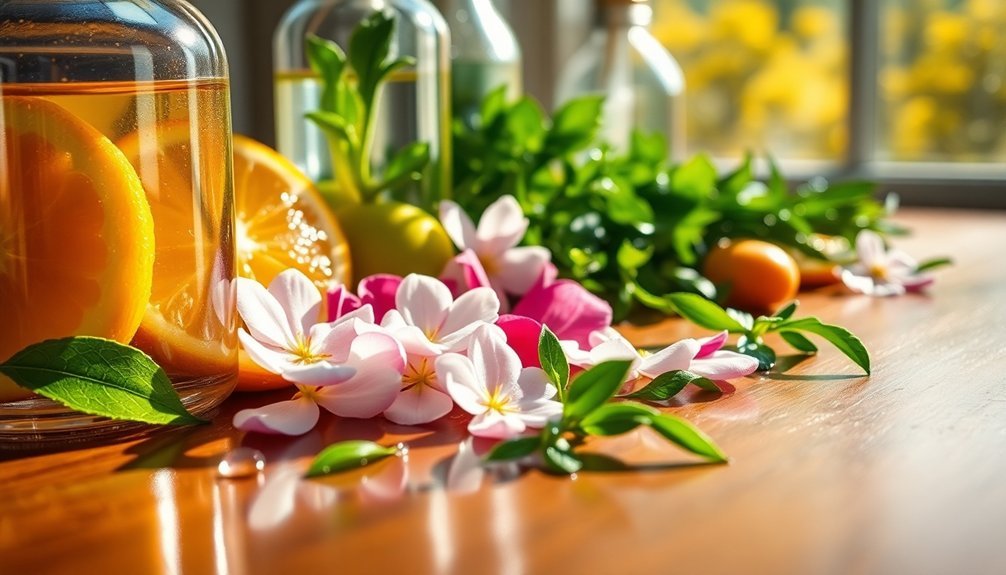
When selecting your fragrance's top notes, you'll find stark contrasts between summer and winter choices: light, fruity watermelon works best in warm weather, while rich vanilla shines in cold months.
You can enhance your seasonal scent by opting for fresh citrus blends in spring and summer or festive spices during autumn and winter celebrations.
These seasonal selections help you create fragrances that perfectly match both the weather and the mood of each time of year.
Summer Vs Winter Notes
As the seasons shift from warm to cold, your choice of fragrance top notes should evolve to match nature's changing moods.
Summer fragrances embrace bright, energetic notes that mirror the season's liveliness, while winter scents wrap you in warmth and comfort.
When selecting your seasonal scent, consider these distinctive characteristics:
- Summer top notes feature citrus and light fruits for an invigorating burst that perfectly suits hot weather.
- Winter top notes incorporate spices like ginger and cinnamon to create a cozy atmosphere.
Both seasonal varieties last only 5-30 minutes but set the tone for your entire fragrance experience.
Fresh or Festive Choices
Choosing between fresh and festive top notes transforms your fragrance from a simple scent into a seasonal statement.
When you're selecting your signature scent, consider how these initial impressions align with the time of year.
For spring and summer, you'll want to embrace citrus-forward top notes like lemon and bergamot, which create an airy, energetic vibe.
These invigorating combinations of fruits and herbs will give you that perfect warm-weather boost.
During fall and winter, you'll find comfort in spicier seasonal top notes, with cinnamon and vanilla creating a warm, welcoming atmosphere.
Tools and Equipment for Top Note Blending
The art of top note blending requires precise tools and equipment to achieve professional results. When your Notes Work depends on having the right essential tools at hand, starting with a high-precision scale and reliable droppers for accurate measurements.
To create lasting, vibrant fragrances, you'll need:
- Dark glass bottles for proper storage and preservation
- Glass stirring rods to prevent contamination
- A pH meter to maintain scent stability
Your success in blending top notes also relies on using an aroma wheel as your guide for selecting complementary scents. This valuable reference tool helps you identify which citrus, floral, or herbal elements will work harmoniously together.
Keep your ingredients organized and protected from light and air exposure to maintain their potency and guarantee consistent quality in your fragrance creations.
Storage and Preservation of Top Note Blends

You'll need to maintain precise temperature control by storing your top note blends in a consistently cool environment between 55-65°F (13-18°C), away from heating vents and windowsills.
Select dark glass bottles with airtight seals to protect your fragrances from oxidation and unwanted chemical reactions that can occur with plastic containers.
Keep your stored blends in a dedicated cabinet or drawer that blocks all light exposure, as UV rays can quickly degrade even the most carefully crafted top notes.
Proper Temperature Control Methods
Proper temperature control stands as one of the most critical factors in preserving your fragrance's top notes.
You'll want to maintain a consistent temperature between 15°C to 20°C (59°F to 68°F) to protect these delicate scent molecules from deterioration. When you expose your fragrances to high temperatures, you risk losing those precious top notes through accelerated evaporation.
To effectively control temperature for your fragrance collection:
- Store your bottles in a dedicated cabinet or drawer away from heating vents and direct sunlight
- Consider using a small wine cooler set to the ideal temperature range
- Monitor room temperature fluctuations, especially during summer months
Ideal Container Selection Tips
Selecting the right container plays an essential role in preserving your fragrance's top notes. When choosing ideal container selection tips, opt for opaque or tinted glass vessels that shield your blend from harmful light exposure.
You'll want to avoid plastic containers, as they can absorb and alter your fragrance compounds over time.
Make certain your container features a tight-sealing cap or pump mechanism to minimize air exposure, which helps maintain the freshness of your top notes.
Store your fragrance in a cool, dry location away from direct sunlight and heat sources to protect its integrity.
Don't forget to clean your containers regularly, as residue buildup can compromise the scent's quality.
These simple but effective storage practices will help guarantee your top notes remain vibrant and true to their intended character.
Light Exposure Prevention Steps
Because light exposure can quickly degrade fragrance compounds, protecting your top note blends requires a strategic storage approach.
Your volatile top notes are particularly susceptible to deterioration when exposed to sunlight, making proper storage vital for maintaining their intended scent profile.
To maximize the longevity of your fragrances, you'll need to implement these protective measures:
- Store your perfumes in opaque or dark-colored bottles to shield them from harmful light rays
- Choose a cool, dark storage location away from windows and direct sunlight
- Keep bottles in their original packaging for an extra layer of protection
Remember to check your collection regularly and rotate older bottles to the front of your storage area.
This practice guarantees you're using fragrances before prolonged exposure can compromise their delicate top notes.
Testing Your Top Note Formulations
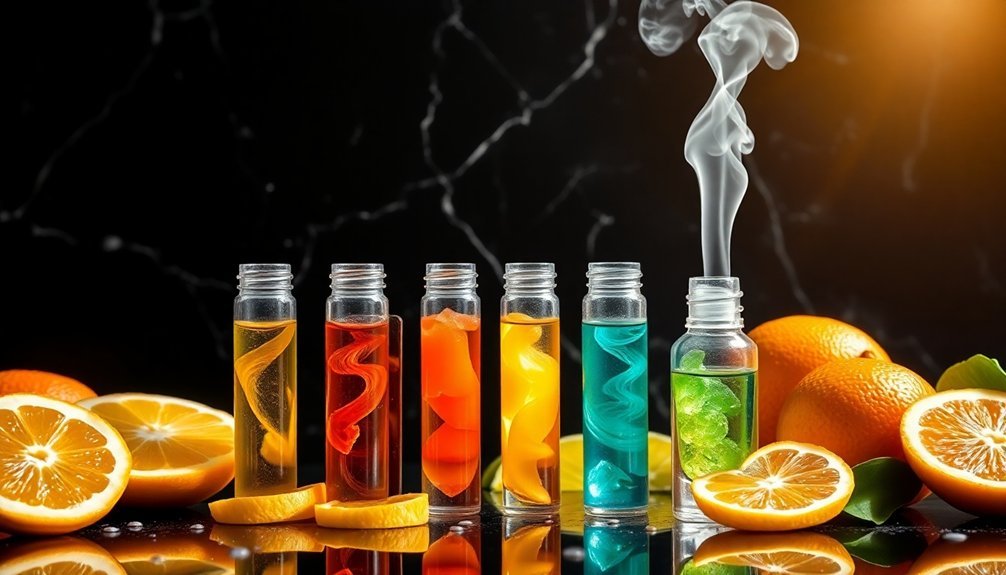
Testing your top note formulations requires a focused approach that centers on the critical first 30 minutes after application. When evaluating these initial scents, pay close attention to the first impression they create, as this moment often determines a fragrance's success.
Focus on how citrus elements like lemon and bergamot, or herbal notes like mint and lavender, interact with your skin chemistry.
During the testing process, trust your emotional response to the top notes. You'll want to observe how they evolve and shift into the middle notes over the 5-to-30-minute window.
Take notes on the scent's progression and how it makes you feel. Remember that personal skin chemistry can greatly alter the fragrance profile, so what works for others mightn't work for you.
Pairing Top Notes With Base Foundations
While creating an enchanting fragrance, pairing top notes with base foundations requires careful consideration of how lighter, volatile elements interact with deeper, lasting scents.
You'll want to guarantee your top notes complement rather than clash with your base notes to create a seamless fragrance journey.
For successful pairings, consider these essential guidelines:
- Combine fresh citrus or mint top notes with rich base notes like vanilla or sandalwood
- Focus on the shift between notes to avoid abrupt changes in the scent profile
- Select base notes that can effectively anchor your chosen top notes
Remember that your base notes will greatly impact how long your fragrance lasts, while your top notes create that critical first impression.
The chemistry between these elements is fundamental – you're aiming for a dynamic interplay that enhances both the immediate appeal and lasting presence of your scent.
Frequently Asked Questions
What Is the Purpose of Top Notes in Perfume?
Top notes give you your first impression of a perfume, creating an immediate hook with fresh, volatile scents that'll entice you. They're brief but essential, lasting up to 30 minutes and setting your fragrance journey's tone.
How Long Do Top Notes Last in Fragrance?
You'll notice top notes last between 5 to 30 minutes after you apply your fragrance. They're quick to evaporate due to their small molecular size, giving you that initial burst of scent.
What Is the Most Important Note in a Fragrance?
Your fragrance's top note is the most important since it's your first impression and lasts 5-30 minutes. If you don't enjoy these initial scents, you're unlikely to appreciate the remaining notes.
Are Top Notes or Base Notes Stronger?
You'll notice base notes last longer, while top notes hit you immediately but fade quickly. Neither is necessarily "stronger" – they serve different purposes in your fragrance, with distinct roles and intensities.
In Summary
You'll find that top notes can make the difference between a forgettable fragrance and an unforgettable one. By understanding volatility, selecting quality essential oils, and mastering proper blending techniques, you're well-equipped to create stunning top note combinations. Remember to test your formulations thoroughly and store them correctly. With practice and patience, you'll develop signature blends that capture attention from the very first spritz.

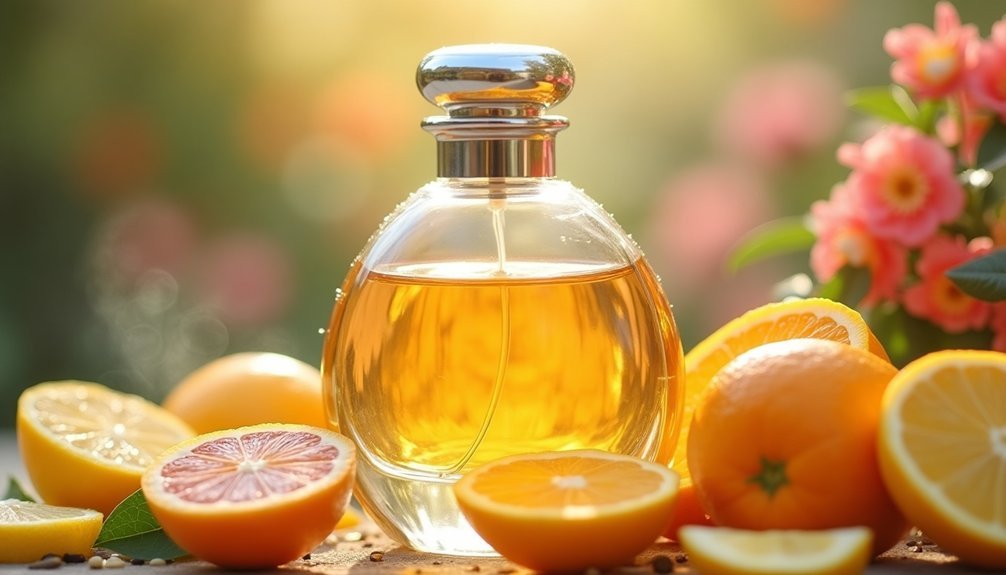



Leave a Reply